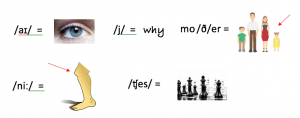By Anna Sobell
Why study pronunciation as part of your language course? The answer to this question should always be ‘how could you not?!’. It would be impossible to learn a language without considering how words, sentences and connected speech (natural speech in conversations, for example) actually sound. With this in mind, why not study the nuts and bolts of pronunciation from the start to ensure an easier ride? Business and verbal communication go hand in hand, and it’s essential that messages are understood and that opinions are clear.
Sounds in languages are known as ‘phonemes’ and they are the individual building blocks of spoken word. As with any sound, phonemes are made through vibrations. The location of the sound will affect the quality of the sound; low, high, long, short, soft, hard etc. If you try speaking without moving your tongue, you’ll quickly notice that this is pretty much impossible. The lips and mouth are also essential tools in the production of clear phonemes; in particular, the shapes we make with our mouth. Try saying ‘this’ and ‘these’. What do you notice about the shape of your mouth? Look at the two shapes below, which relates to ‘this’ and which to ‘that’?

“Pusiness bartners broduce blan for barty!”
“What? Sorry, could you repeat that please?” would be the likely response to the sentence above! Having read the sentence, I’m sure you’ll get the meaning, however hearing it would be another story. The problem here is of course the pronunciation of the phonemes /b/ and /p/. This is a common problem with Arabic speakers learning English, and the following is a great tip for trainers to use in lessons. /b/ and /p/ are both made in the same part of the mouth, with the lips in the same position; the only difference is that /b/ is voiced and /p/ isn’t. A useful teaching trick is to ask your learner to say the words ‘pen’ and ‘bag’ whilst holding a piece of paper in front of their mouth. When the /p/ sound is made, the paper should flick forward because of the flow of air, but stay still when /b/ is made. This is an effective, practical and memorable method to highlight the distinction between these two troublesome sounds.
Another tip for teachers to help with demonstrating the difference between voiced sounds (with noticeable vibration) and unvoiced sounds (without noticeable vibration), but this time with the /θ/and the /ð/ phonemes. The latter is the voiced ‘th’ sound in ‘mother’. The former is the unvoiced ‘th’ sound in ‘thanks’. This distinction in sound can be demonstrated by asking the learner to put his or her finger on his or her throat and say the words. They will notice that the voiced sound creates vibration through the throat whilst the unvoiced doesn’t- this is exactly why the two phonemes sound different!
It’s also a good idea to agree some silent gestures with your learners to signal a pronunciation error when they are speaking for fluency. For example; when I was teaching Italian learners, I would hold up my hand flat in front of my mouth and make a quiet ‘h’ sound to signal the typical Italian error of omitting the /h/ at the start of a word.
/waɪ juːz ðə fəniːmɪk ʧɑːt/?
Good question! The phonemic chart is a kind of alphabet made up of symbols to represent all the sounds of the English language. You can find a great and interactive example from the British Council here- https://www.teachingenglish.org.uk/article/phonemic-chart. It is also really useful for both teachers and learners studying English, and can be lots of fun too! Try to figure out the meaning of the question above by following these clues (answer at the bottom of the page):

|
|
|